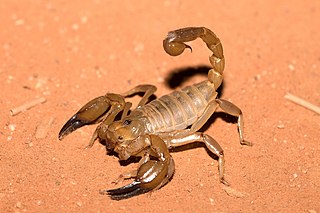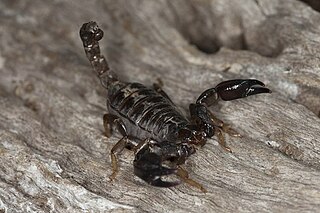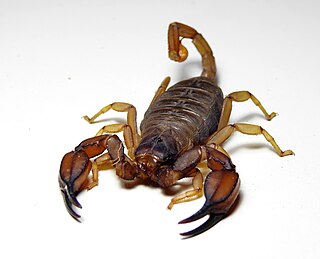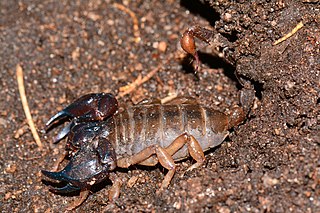
Urodacus is a genus of scorpion belonging to the family Urodacidae. It was described by German naturalist Wilhelm Peters in 1861. The type species is U. novaehollandiae. Its species are native to Australia, and dig burrows. The genus was placed in its own family in 2000. Before this, the group had been a subfamily Urodacinae within the family Scorpionidae. There are likely many undescribed, cryptic species within the genus.

Urodacus manicatus, commonly known as the black rock scorpion, is a species of scorpion belonging to the family Urodacidae. It is native to eastern Australia.

Urodacus yaschenkoi, also known as the inland scorpion or the desert scorpion, is a species of scorpion belonging to the family Urodacidae. It is native to central Australia. It is also referred as the desert robust scorpion, because of its robust black colour and a long tail lined with a deadly hook.

Urodacus elongatus, commonly known as the Flinders Range scorpion, is a species of scorpion belonging to the family Urodacidae. They are endemic to the Flinders Ranges of South Australia. They were described by L.E. Koch in 1977.
Urodacus centralis is a species of scorpion in the Urodacidae family. It has a limited range in central Australia, and was first described in 1977.
Urodacus butleri is a species of scorpion in the Urodacidae family. It is endemic to Australia, and was first described in 2012.
Urodacus hoplurus is a species of scorpion in the Urodacidae family. It is endemic to Australia, and was first described in 1898 by British zoologist Reginald Innes Pocock.
Urodacus macrurus is a species of scorpion in the Urodacidae family. It is endemic to Australia, and was first described in 1899 by British zoologist Reginald Innes Pocock.

Urodacus planimanus is a species of scorpion in the Urodacidae family. It is endemic to Australia, and was first described in 1893 by British zoologist Reginald Innes Pocock.
Urodacus spinatus is a species of scorpion in the Urodacidae family. It is endemic to Australia, and was first described in 1902 by British zoologist Reginald Innes Pocock.
Urodacus giulianii is a species of scorpion in the Urodacidae family. It is endemic to Australia, and was first described in 1977 by L. E. Koch.
Urodacus koolanensis is a species of scorpion in the Urodacidae family. It is endemic to Australia, and was first described in 1977 by L. E. Koch.
Urodacus lowei is a species of scorpion in the Urodacidae family. It is endemic to Australia, and was first described in 1977 by L. E. Koch.
Urodacus megamastigus is a species of scorpion in the Urodacidae family. It is endemic to Australia, and was first described in 1977 by L. E. Koch.
Urodacus similis is a species of scorpion in the Urodacidae family. It is endemic to Australia, and was first described in 1977 by L. E. Koch.

Urodacus hartmeyeri is a species of scorpion in the Urodacidae family. It is endemic to Australia, and was first described in 1908 by German naturalist Karl Kraepelin.
Urodacus mckenziei is a species of scorpion in the Urodacidae family. It is endemic to Australia, and was first described in 2000 by Erich Volschenk, Graeme Smith and Mark Harvey.

Urodacus novaehollandiae, also known as the coastal burrowing scorpion or black sand scorpion, is a species of scorpion in the Urodacidae family. It is endemic to Australia, and was first described in 1861 by German naturaliat Wilhelm Peters.
Urodacus varians is a species of scorpion in the Urodacidae family. It is endemic to Australia, and was first described in 1963 by Australian paleontologist and Western Australian Museum curator Ludwig Glauert.

Urodacus lunatus is a rare species of burrowing scorpion in the family Urodacidae. It is endemic to the northern part of western Australia and was described in 2023.









